This was published 6 months ago
London calling: UK capital offers lessons for Melbourne’s housing woes
By Adam Carey
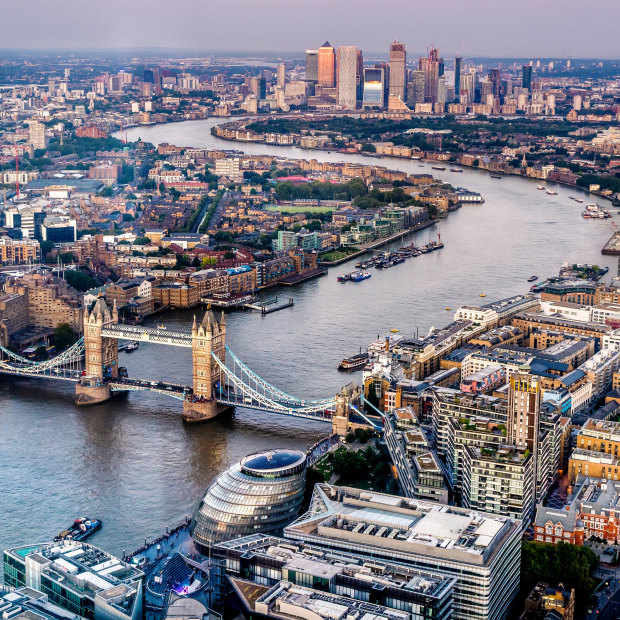
London is home to 9 million people, a population Melbourne is forecast reach by about 2050.Credit: Getty Images
Five days a week in Barking, a culturally diverse suburb in East London, the main street fills with shoppers at one of the UK capital’s oldest open-air markets.
Stallholders sell everyday items ranging from watch batteries and £1 shirts to fresh flounder. Street-food vendors scent the air with smells of exotic global cuisines: Romanian cevapi; Tanzanian biryani.
It’s alive and atmospheric. An authentic slice of life in one of the world’s most magnetic cities. But you probably won’t spot any tourists.
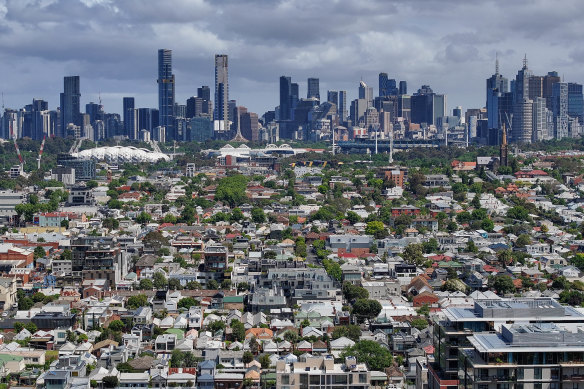
Melbourne’s population is growing at more than twice the rate of London’s.Credit: Joe Armao
Working-class Barking is a 45-minute Tube ride from central London. No iconic landmarks like the Eye or the Gherkin gild its skyline. It’s an unfussy place, where people live, work and struggle to get ahead. Or just to get by.
Perhaps it’s a bit like Dandenong, if one is looking for a Melbourne equivalent. Its greatest appeal is its affordability: it’s one of the last places in London where families on average incomes can hope to buy a home.
London has become a touchstone for Victorian Premier Jacinta Allan and her government as they argue the case for their contentious plan to build 800,000 new homes in Melbourne, and for the state’s costliest ever project, the Suburban Rail Loop.
“By the 2050s, our city will be the same size as London is today. And we need the infrastructure to match,” Allan posted on Facebook in July, with a clipping of an Age story from 1970 that condemned the City Loop as a “$54 million underground folly”.
The inference of the premier’s post was clear: this might seem expensive now, but imagine the cost of not doing it?
Allan pressed the accelerator on her housing strategy last week, revealing 25 more Melbourne places that will be targeted for an apartment boom. In Brighton, Auburn, Blackburn, Sandringham, Mitcham, and 20 other unsuspecting parts of middle suburbia, planning controls will be rewritten to make it easier and quicker to build housing that is taller and more densely populated.
The premier pitched her higher-density urban plan as a strategy to help priced-out millennials buy a home.
“The ratio of house prices to the median wage isn’t three to one any more. It’s more like 10 to one.
It’s not a $60,000 house on a $20,000 wage. For a 34-year-old now, it’s an $800,000 house on an $80,000 wage,” Allan told the Melbourne Press Club on Thursday.
A tale of two crises
London is home to 9 million people, Melbourne to 5.3 million. Both are grappling with a housing affordability crisis that public officials see as the most pressing issue facing their cities.
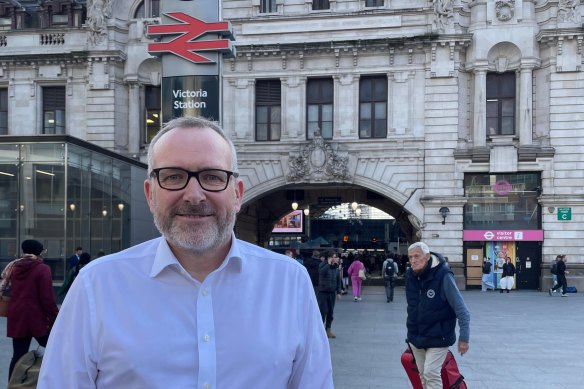
Graeme Craig, chief executive of Places for London, is on a mission to build homes on the city’s railway-owned land.Credit: Adam Carey
“London, Melbourne: both cities have a housing crisis that ultimately threatens the future growth of those cities,” says Graeme Craig, the chief executive of Places for London. Essential workers are being squeezed out of the rental and home ownership markets, threatening social cohesion.
“You need places for teachers and nurses, and everyone else to be able to live,” Craig says.
Craig is uniquely well-placed to tackle London’s housing crisis. He runs the property development arm of Transport for London, which controls the city’s world-famous Underground. It’s his mission to maximise opportunities for affordable housing on railway-owned land.
“If you’re going to build dense anywhere, you build dense immediately around the transport network,” he says.
London’s housing crisis is acute. Late last year, London councils estimated as many as one in 50 Londoners was homeless. Almost half of them were children.
For this reason, London has set fiercely ambitious targets for affordable housing.
This month, Places for London confirmed plans to build 4000 new homes in Earls Court, working with private developers. Thirty-five per cent of them will be affordable, the minimum proportion the publicly owned developer will accept, even though it is in the business of making a profit.
“We’re clear that we’re a commercial entity, but also we’re very clear about the fact that we want to address the challenges that the city’s facing,” Craig says.
The UK capital has set a target of building 65,000 new homes a year over 10 years, which is lower than the Allan government’s target for Melbourne of 80,000 homes a year. If it’s surprising that Melbourne’s target exceeds London’s, perhaps it shouldn’t be.
Both cities are growing thanks to large migration intakes, but Melbourne’s current rate of growth is more than double London’s. Melbourne grew by 167,500 people in 2022-23, according to the Australian Bureau of Statistics, compared with 76,300 who were added to already teeming London.
Aiming high for affordability
It’s unlikely Allan and her ministers have Barking in mind when they think of London. But it is where one of the most promising solutions to London’s housing crisis is unfolding.
Ten years ago, Barking had the worst homelessness rate in London. So the council did something it had not attempted since the 1960s: it became a developer, setting up its own not-for-profit company to fund and build homes.
Just a few minutes’ walk from the open-air market, the fruits of the council’s development play have begun to ripen. One of London’s largest urban regeneration projects is under way.
Fifty-thousand new homes are being built, including on the site of a demolished 1960s public housing estate that had fallen into disrepair.
The new housing estate is being built by Be First, a development company wholly owned by the local Barking and Dagenham Council.
Barking’s ongoing, £700 million ($1.36 billion) redevelopment did bring disruption to the community, Be First senior development manager Dubravka Polic said. Many of the residents who were displaced from the old towers never returned.
“But this was a deeply problematic estate, both in terms of ongoing maintenance cost and also crime and anti-social behaviour. So in a way, people wanted to see an improvement,” Polic said.
The buildings that have gone up in place of the old towers are architecturally attractive. They have been built with an emphasis on landscaping, with inviting gardens, open spaces and wide, light-filled walkways between a series of mid-rise towers.
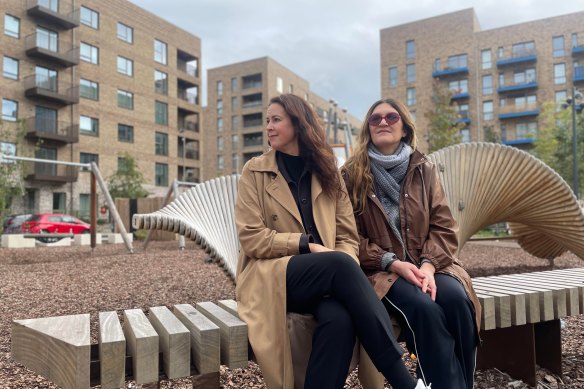
Linda Thiel (left), director at White Arkitekter, and Dubravka Polic, a senior development manager at Be First, at the Gascoigne Neighbourhood in Barking, one of the largest urban regeneration sites in London.Credit: Adam Carey
Three-quarters of the homes being built in Barking will be leased at a range of affordable rates, including for residents of the demolished towers, who have been given the right of return. Homes that are leased at market rates help pay for the estate’s affordable homes.
And they are “tenure blind”, meaning that the public and privately owned homes are not segregated. It is not possible to tell from the street which homes are affordable and which are market-value.
Linda Thiel is director at White Arkitekter which designed the Scandinavian-inspired estate.
Thiel said the practice began its design work by asking why people would want to move into these neighbourhoods, rather than seeing it as simply a challenge to build more homes in a crisis.
“There is a challenge to deliver density while making it liveable and sustainable. Landscaping is critical,” she said.
The proportion of publicly owned homes being built in Barking far exceeds the Allan government’s plan for Melbourne’s 44 ageing public housing towers. The 10,000 homes they contain will be replaced by 30,000 homes, with 11,000 to be social and affordable housing.
That total would barely meet the City of London’s 35 per cent affordable housing threshold for fast-track approval of developments on private land, and fall well short of its 50 per cent threshold on public land.
Planning Institute of Australia Victorian president Patrick Fensham said London’s affordable housing targets showed a genuine commitment to tackling housing stress.
“It’s so much more advanced than us in terms of the mix of options and funding,” he said.
The spectrum of definitions of affordable housing in London – which covers everything from apartments leased at 80 per cent of the going market rate, to those that are fully subsidised – provides a more reliable funding stream than Victoria’s Development Facilitation Program, Fensham said.
Under that program, projects that include 10 per cent affordable housing are fast-tracked for approval.
“It’s generating chicken feed compared to what we need and what a more universal and more contributory charge would bring,” Fensham said.
‘We build what we can’
Barking and Dagenham is not the only London council venturing into property development.
Travel one Tube stop west of Barking along the District Line to East Ham, and you will find a cluster of smaller-scale affordable housing projects near the station.
The council there, Newham, didn’t have the same blank slate that Be First had on which to design new housing. Here, its development company, Populo Living, has found a solution in keeping with a crowded city where land is scarce.
Using “air rights”, it builds new homes on top of old homes, and above repurposed heritage buildings such as the local town hall.
“We build what we can build with the land that we have,” says Duncan Hayes, a spokesman for Populo Living.
The not-for profit company manages 795 homes for rent, 251 of which are leased at affordable rates.
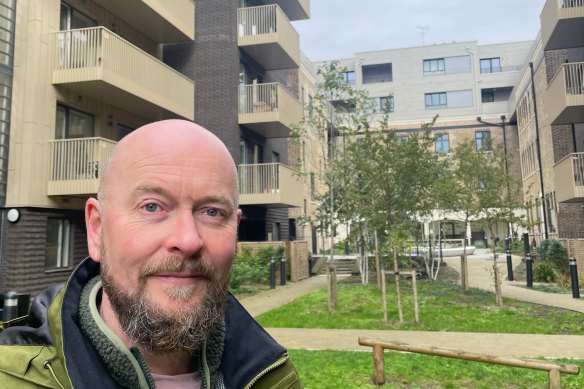
Duncan Hayes, of Newham Council-owned development company Populo Living, inside the courtyard of an apartment development built around the old town hall.Credit: Adam Carey
Hayes says the company “is always aiming for 50 per cent affordable”, but that London’s housing market sometimes makes the target unviable for a financially constrained local council.
But all profit Populo makes from leasing its homes at market rents is funnelled straight back into building affordable housing.
No parking allowed
In his quest to drive a housing boom along London’s rail lines, Graeme Craig has a colossal ally: the Elizabeth line.
Named after Queen Elizabeth II, the £19 billion ($37.15 billion) underground line is the most expensive transport project in Britain’s history. Crossrail, as it was known before it opened in 2022, has tunnelled a transformational east-west pathway beneath London.
It has also spurred a housing boom: property analysts CBRE estimates 33,600 new homes have been built around its 41 stations since 2009, contributing more than 10 per cent of the city’s total new housing.
Housing has become a key mooted benefit for Labor’s Suburban Rail Loop, which at $34.5 billion is scarcely less costly than Crossrail.
Tunnelling work has not even started, but the government has already assumed planning controls in a radius of about 800 metres around each of the project’s six stations, in Box Hill, Burwood, Glen Waverley, Monash, Clayton and Cheltenham. This is so that 70,000 new homes can be built there, it says.
The projects in Earls Court, Barking and East Ham share one common feature that is virtually alien to Melbourne: no new car parking.
London made a seismic shift in its planning rules 20 years ago, scrapping minimum parking provisions for new housing, and enforcing maximums instead.
“The London plan has a predisposition against new car parking spaces, and we will generally look to minimise or avoid any car parking spaces,” Craig said.
The Allan government has been quietly exploring following London’s cue, and removing minimum car parking requirements for new apartments built near train stations and tram lines.
Dr Chris De Gruyter, a transport and planning expert at RMIT University, said increased housing density along Melbourne railway lines has not been matched by an increase in services.
His research found the number of apartments in Melbourne grew by 88 per cent between 2004 and 2022, while train and tram services near those new homes grew by 5 per cent.
De Gruyter said Melbourne had adopted London’s practice of building up around transport hubs, but missed the critical requirement to build up provision of public transport too.
“Melbourne needs to integrate transport and land use, and the reality is we haven’t been doing much of that,” he said.
“There’s been more of a one-way mechanism at play, where housing is directed to where there is PT, but PT has not responded to that and has largely stayed static.”
Adam Carey travelled to London with the assistance of Uber.
Start the day with a summary of the day’s most important and interesting stories, analysis and insights. Sign up for our Morning Edition newsletter.